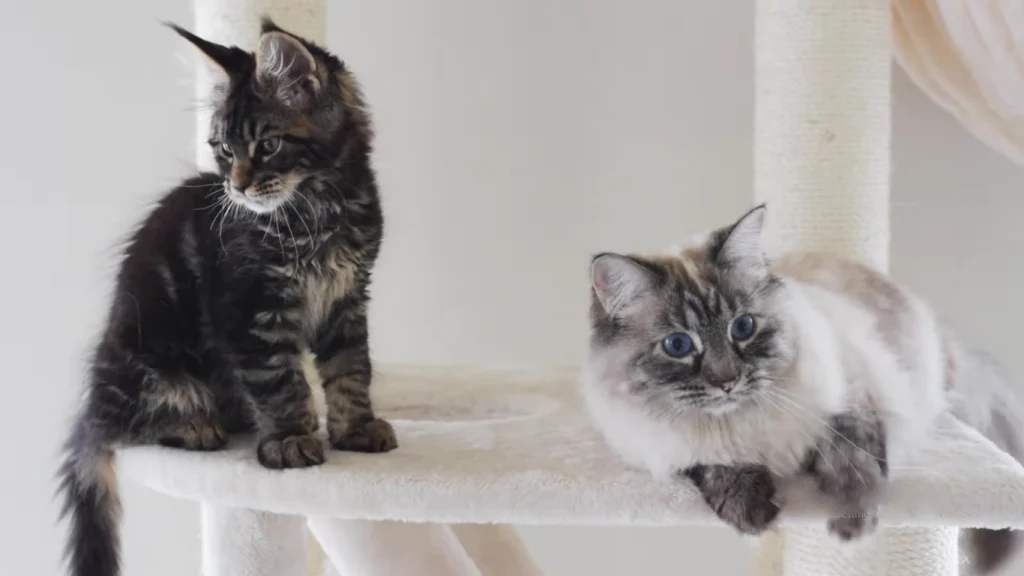How to Introduce a Kitten to an Older Cat: A Step-by-Step Guide for a Smooth Transition
By: Elizabeth Rikas

The information in this article is intended to educate cat parents and is not a substitute for veterinary guidance. In case of any concerns about your cat’s health, please talk with your veterinarian.
Adding a new kitten to a home with an older cat can be both exciting and challenging. The key to a successful introduction is to take it slow and allow both cats to adjust to each other’s presence over time. Many cat owners worry about how their resident feline will react to a newcomer. With the right approach, these fears can be eased.
Before introducing the cats, it’s crucial to prepare the home. Creating a safe space for the kitten and ensuring the older cat feels secure will help reduce stress for both pets. Gradual introductions can promote positive interactions and prevent feelings of territoriality from the established cat.
Once both cats begin to feel more comfortable, the real introduction can happen. Keeping a close eye on their interactions, while offering plenty of love and attention to each pet, will pave the way for a cohesive household. With patience and care, they can learn to coexist peacefully.
Key Takeaways:
- Preparing a safe space for the new kitten is essential.
- Gradual introductions help reduce stress for both cats.
- Ongoing care ensures harmony in the household.
Interesting Read: Best age to declaw a cat
Preparing for Arrival
Getting ready for a new kitten involves creating a safe space and gathering the right items to ensure a smooth introduction. This preparation is crucial for the well-being of both the new kitten and the older cat.
Set Up a Safe Room
A safe room provides a secure area for the new kitten to adjust to the home. This room should be quiet and away from the older cat’s main territory.
To set up this space, include:
- Food and Water Bowls: Place one bowl for food and another for water. Ensure they are easily accessible.
- Litter Box: Add a litter box to promote good habits right from the start. Choose a box that is easy for the kitten to enter.
- Cozy Bed: Provide a soft bed or blanket for comfort and warmth.
- Toys: Include a few toys to keep the kitten engaged and offer outlets for energy.
This setup helps the kitten feel safe and reduces stress during the initial transition.
Gather Essential Supplies
In addition to the safe room, gathering essential supplies is vital for the kitten’s well-being. Items should be chosen carefully to create a welcoming environment.
Consider these supplies:
- Carrier: A secure carrier is important for transporting the kitten, especially for vet visits. Choose one that is easy to use.
- Baby Gate: If needed, a baby gate can help keep the kitten and the older cat separated initially while allowing them to see each other.
- Scratching Post: This will encourage appropriate scratching behavior and help prevent furniture damage.
- Interactive Toys: Select toys
Having these supplies ready will ease the adjustment for everyone involved.
Click to explore: How To Make Cats’ Fur Softer
The Introduction Process
Introducing a kitten to an older cat requires careful planning. The process involves two key steps that help ease the transition for both cats. These steps are scent swapping and conducting a face-to-face meeting. Completing these actions thoughtfully can significantly reduce stress for the older cat while allowing the newcomer to settle in.
Scent Swapping Technique
Scent is an important factor in how cats perceive each other. To begin, designate a safe space for the kitten. Place items such as a blanket or toy in this space. Let the older cat explore these items, which will help them get familiar with the kitten’s scent.
Next, take something with the older cat’s scent, like a cloth or toy, and introduce it to the kitten. Keep the new items separate but rotate them every few days. This slow introduction method helps both cats develop a sense of comfort with each other’s smells, laying the groundwork for a smoother face-to-face meeting later on.
Conducting a Face-to-Face Meeting
After scents have been exchanged for several days, it’s time for a face-to-face meeting. Use a baby gate to create a barrier between the two cats. This allows them to see and hear each other while staying safe.
Keep the first meeting short, about 5–10 minutes. Monitor their body language for signs of stress or aggression. If they show interest or curiosity, reward them with treats to create positive associations. If either cat appears tense, separate them and give it more time before trying again. Gradually increase the duration of the meetings as they become more comfortable. This structured approach helps pave the way for a peaceful coexistence.
Click to learn about: When do kittens calm down
Post-Introduction Care
After introducing a kitten to an older cat, it is important to ensure both animals adjust well. Creating a suitable environment and focusing on health will help the two cats to coexist peacefully.
Creating a Harmonious Environment
A harmonious environment is key for both the new kitten and the resident adult cat. First, establish distinct spaces for each cat to retreat to when feeling stressed. Providing separate food and water bowls helps minimize competition.
Adding a scratching post can give each cat a safe outlet for their natural scratching behavior. It is also helpful to use pheromone products designed for cats. These can create a calming atmosphere and help reduce stress during the adjustment period.
Routine is also important. Keeping feeding and playtime consistent can help both pets feel secure. If they seem to enjoy each other’s company, gradual supervised play can foster a positive relationship.
Health and Wellness Considerations
Health is a critical factor when introducing a kitten to an older cat. Ensuring both animals are spayed or neutered is essential. This helps prevent territorial behavior and unwanted litters.
Regular vet check-ups should be a priority. Both cats need to be up to date on vaccines and parasite control. This is particularly important for preventing the spread of diseases.
Monitor both cats for signs of stress or illness. Changes in eating habits, litter box usage, or behavior may indicate adjustment issues or health concerns. If either cat shows unusual signs, consulting a veterinarian is advisable. Keeping both cats healthy will support a positive relationship, leading to a happier home.
Click to know what is: Fever Coat In Kittens
Frequently Asked Questions
Introducing a new kitten to an older cat can raise many questions. Knowing what signs to look for and how to manage the process can help ensure a smoother transition for both pets.
Conclusion
Introducing a kitten to an older cat requires patience, preparation, and a gradual approach. By setting up a safe space, using scent swapping, and supervising initial interactions, you can ease the transition for both pets. A well-planned introduction fosters harmony, reducing stress and territorial behaviors.
With time, most cats adjust and even form bonds, creating a peaceful multi-cat household. Consistency, positive reinforcement, and monitoring their health ensure long-term success. Remember, every cat is unique—adjust the process based on their comfort levels for the best results.

About the Author
Elizabeth Rikas
Elizabeth is a passionate advocate for feline health and well-being, drawing from her years as a dedicated pet parent to three cats—Gypsy, Swan, and Alfred—and her invaluable experience volunteering at animal shelters. A seasoned writer with a lifelong love for cats, Elizabeth began sharing her insights in her teens and has since contributed extensively to platforms focused on feline care. Through her expertise and heartfelt dedication, she empowers pet owners with practical advice and research-backed knowledge to nurture their furry companions.
